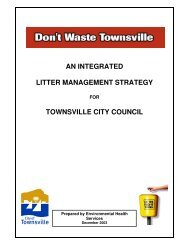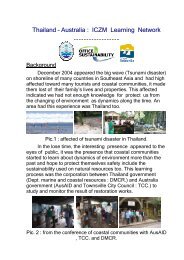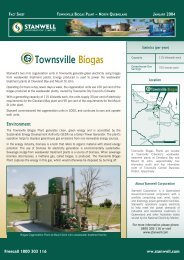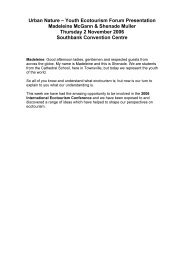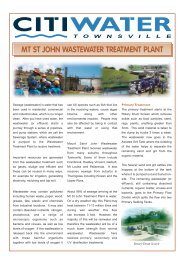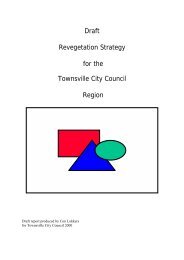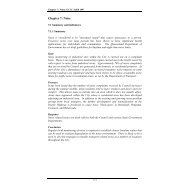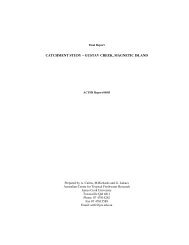ENVI RONMENTAL HI STORY OF ROWES BAY - Townsville State ...
ENVI RONMENTAL HI STORY OF ROWES BAY - Townsville State ...
ENVI RONMENTAL HI STORY OF ROWES BAY - Townsville State ...
- No tags were found...
You also want an ePaper? Increase the reach of your titles
YUMPU automatically turns print PDFs into web optimized ePapers that Google loves.
5Environmental history of Rowes Bay• Sand is delivered to Cleveland Bay by the Ross River. This probably occurs episodicallyduring flood events.• Sand is moved northwest along the shoreline by longshore drift processes in the upperintertidal zone of the beach face.• Sand moves along the Strand Beach and around Kissing Point into Rowes Bay.• Initially sand is trapped in the embayment by Many Peaks Range until the shorelineadvances to be level with Cape Pallarenda.• Today, sand moves northwards along the Rowes Bay - Pallarenda beach, and eventuallyleaves Cleveland Bay to the north past Cape Pallarenda.Quantification of all the steps in this model is not possible. However, from the above discussion ofrecent geological history and sediment transport in the embayment, one step in this budget can bequantified - the in-filling of the embayment. This then allows the nett rate of long-term sand supplyto be calculated as follows.• Area of sand in the Kissing Point - Many Peaks Range embayment can be measuredfrom the geological map (Trezise et al, 1989) = 8.3 km 2 .• Average depth of sand deposits is estimated to be between 1.5 – 2 m.• Total volume of sand in the embayment is between 12,500,000 – 16,700,000 m 3 .• Sand accumulated over 5000 year period at a rate of 2500 – 3300 m 3 per year.For the shoreline to maintain a long-term stable position there needs to be a nett supply of sand ofthat balances the rate of northwards longshore drift. As a first approximation, this longshore driftrate is probably the same as the rate at which the embayment filled - ie about 2500 – 3300 m 3 peryear.4. The Pre-European Environment4.1 IntroductionThere is little information on the pre-European environment of Rowes Bay. The early settlers didnot make any direct record of the landscape that they found, however early sketch maps, charts,photographs and historical descriptions can be interpreted to give a probable picture of the coastallandscape. Figure 3 shows the shoreline in much the form it would have been at that time. Theshoreline will be considered in three sectors:i) Kissing Point headland (705 m);ii) Inner Rowes Bay from the Esplanade, through Soroptimists Park to One Mile Creekdrain (1,200 m); andiii) North Rowes Bay extending from One Mile Creek drain (1,100 m).4.2 Kissing Point HeadlandThe Kissing Point headland is a granite hill rising to 34 m above sea level, and separates RowesBay from the Strand beach. The shoreline consists of a 30 – 50 m wide rocky inter-tidal shoreplatform, with the upper part of this was mostly covered by sand. The earliest hydrographic chart ofCleveland Bay dates from 1886, and this shows a suite of sub-tidal bars extending for 2 kmnorthwest from the point across into Rowes Bay. These were probably sandbars formed of sedimenttransported past Kissing Point by southeasterly waves.4.3 Inner Rowes BayAround inner Rowes Bay, the shoreline consisted of constantly changing sandbars, sand spits andbeaches formed across the mouths of two streams. The streams drained across estuarine mudflatsthat occupied much of the area between Kissing Point and Castle Hill. The eastern stream drainedthe sand hills of North Ward and the slopes of Castle Hill, and was probably the outlet for



